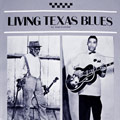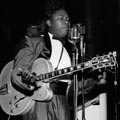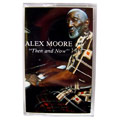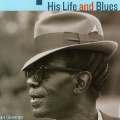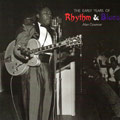The Piano Blues of Dr. Hepcat
Lavada Durst
About
Details: Audio Cassette, 1994, Produced and Recorded by Alan Govenar
Track Listing: Hey, Chappie, Lo Chicks (Jive Talk) :11, Let Me Peek Through Your Window 4:00, Black Gal 2:40, Piggly Wiggly 4:13, History of the Blues 7:11, Evil Woman Blues 4:15, The Black Tank Good Life Blues 5:40, Hepcat’s Boogie 3:21, Looking Back 8:20, How Long 3:21, I Need My Baby 5:21, Shaw’s Blues 1:03, Talking Blues 3:53, Hattie Green 3:25, Lord Have Mercy 4:38, The Hepcat’s Prayer (Jive Talk) :34
Born in Austin, Texas, January 9, 1913, Durst learned to play the piano as a child and emulated the styles he heard growing up. "I was self-taught," he recalls "I used to slip across the street to the church house and one-finger that piano. I had heard Meade Lux Lewis and Pete Johnson on record, and around Austin, I heard a lot of piano players, Baby Dotson, Black Tank, and Boots Walton." The songs in Durst's repertory are mostly traditional and usually feature renditions of his earlier recordings "Hattie Green," 'I Cried All Night," and "Hepcat's Boogie," accompanied by others that he learned as a young man, such as "How long," "Piggly Wiggly " "Evil Woman," and 'Black Gal." Some of his songs are original, including "I Need My Baby," a slow- tempo blues, and "Looking Back" and "History of the Blues," which are essentially talking blues that recount Durst's early years and the house-rent parties of his youth. In his playing Durst combines elements of barrelhouse and boogie woogie with improvisatory talking blues and jive. "My left hand was influenced by the solid bass that I heard on the records of Albert Ammons, Meade Lux Lewis, and Pinetop Smith," Durst says, "but my right hand goes crazy with those Sugar Land riffs that I learned from Robert Shaw. I like to finger the piano lightly." This audiocassette recording was produced by Alan Govenar and, funded by Documentary Arts, Inc.
Liner Notes
When Lavada Durst sits at the piano, he likes to “tickle the keys.” As he starts to play, his face lights up and the music rambles out, a kind of talking blues that is at once traditional and personal, improvised to meet the emotions of the moment at hand. Born in Austin, Texas, January 9, 1913, Durst learned how to play the piano as a child and emulated the styles he heard growing up. “I was self-taught, “ he recalls, “I used to slip across the street to the church house and one-finger that piano. I had heard Meade Lux Lewis and Pete Johnson on record, and around Austin, I heard a lot of piano players, Baby Dotson, Black Tank, and Boots Walton.”
In 1933 Durst met the legendary Robert Shaw, who was then living in Austin. “Robert was a master of barrelhouse blues who played that Sugar Land (Texas) style of fast piano,” Durst says, “combing blues with ragtime and stride.” From Shaw (Arhoolie CD 377), Durst learned the rudiments of what is now referred to as the Texas barrelhouse piano style. Over the years, Durst has carried on and elaborated this tradition, although his audience has changed: “When I was young I used to play at house-rent parties, barbeques, and Saturday night suppers, and then after I became a disc jockey, I would make appearances with different bands. I played some with Johnny Simmons, who passed some time ago, but was one of the best musicians in this area of Texas. As a novelty I’d take over the piano for a few numbers and his band would kind of back me up.”
Durst worked part time as a disc jockey from 1948 to 1963 on KVET radio in Austin. On the air, he used the call name “Dr. Hepcat,” and during his show, which featured primarily rhythm and blues and jazz, he used to jive talk to pique the interests of his listeners in making introductions to records, public service announcements, and commercials.
In the early 1950s Durst met the legendary Don Robey: “He had already started Peacock Records, and he’d contact all the black disc jockeys. He came to Austin promoting records, and I told him about my playing and about a local spiritual group called the Bells of Joy which Robey later recorded.” Durst claims to have written a song for the Bells of Joy called “Let’s Talk About Jesus,” which became their first big hit. Unfortunately, Durst was never credited and never received payment or royalties: “I was too ignorant to put down that I was the author because I was a blues singer,” he says. “At that time people were stifled by tradition. Blues and spiritual songs didn’t mix. Of course, I found out later that these old traditions didn’t hold much water.”
In 1953 and 1954 Durst recorded two sides for the Peacock label himself. His recordings included “Hattie Green” and “I Cried All Night”, and featured Durst of the piano backed by studio musicians playing guitar, tenor saxophone, trumpet , and drums. About these sessions, Durst says, “I had some idea of what to expect. I had already recorded ‘Hattie Green’ and ‘Hepcat’s Boogie’ around 1949, 1950, for Fred Caldwell, the program director at KVET.” Caldwell owned the Austin-based Uptown label, but Durst never got any royalties. “I was hoodwinked into that,” Durst states. “Caldwell later got fired at KVET and was replaced by Bill Deeson. So, when Robey came along, I was ready to record again, but it didn’t turn out much better. I made the record, but it never went anywhere on the charts, and I didn’t get anything out of that other than the fifty or so dollars I got paid after the recording session.”
In the late 1950s Durst became the manager of The Chariottes, an Austin-based spiritual group composed of six black women: “They recorded some songs for Robey using my lyrics. One of their better-known numbers was ‘Step by Step,' which was eventually made into sheet music. You can still find it in churches today, but I got no money for that either.”
During the late 1960s Durst’s interests changed. He became more involved with his church and in 1965 was ordained a minister at the Mt. Olive Baptist Church in Austin. He held this position until 1972, when he was named Associate Minister at the Olivet Baptist Church, where he still works today.
Durst stopped playing the piano between 1965 and 1975. “If you belonged to the church, “he says, “and you were a Christian, then you were not supposed to play the blues. But my values were set straight by Dr. Wicks, pastor of the Olivet Baptist Church, who said, ‘Gifts are God given and it’s no harm to pursue your God-given gift.’ So, I started playing again and soon I was contacted by different arts groups and started playing for them at festivals, but I refused to play in bars and nightclubs.”
In the early 1980s Documentary Arts recorded Durst as part of a compilation entitled “Deep Ellum Blues” that was released in 1986. In 1987 Tary Owens assembled the “Texas Blues Reunion” and later issued a compilation album called Texas Piano Professors on his catfish label (#1002) which featured Durst with Erbie Bowser, T.D. Bell, and Grey Ghost.
The songs in Durst’s repertory are mostly traditional and usually feature renditions of his earlier recordings, “Hattie Green,” I Cried All Night,” and Hepcat’s Boogie,” accompanied by others that he learned as a young man, such as “How Long,” “Piggly Wiggly,” “Evil Woman,” and “Black Gal.” Some of his songs are original, including “I Need My Baby,” a slow-tempo blues, and “Looking Back” and “History of the Blues,” which are essentially taking blues that recount Durst’s early years and the house-rent parties of his youth. In his playing, Durst combines the elements of barrelhouse and boogie woogie with improvisatory talking blues and jive. “My left hand was influenced by the solid bass that I heard on the records of Albert Ammons, Meade Lux Lewis, and Pinetop Smith,“ Durst says, “but my right hand goes crazy with those Sugar Land riffs that I learned from Robert Shaw. I like to finger the piano lightly.”
Alan Govenar
1994


